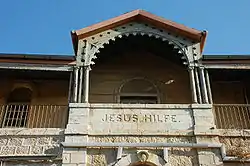Hansen House (Jerusalem)
Historical background
The Protestant community of Jerusalem built the asylum in 1887, according to German architect Conrad Schick's plan. The inscription of the asylum's name—“Jesus Life”—remains on the building's main façade. The founders purposely chose a secluded site, away from the Old City walls, and enclosed the compound with a wall. The Herrenhut Brotherhood of the Moravian Church were responsible for fundraising and management, recruiting staff from Europe to care for the predominantly Muslim patients. Over the years, Jerusalem grew until the asylum's location was no longer secluded yet it retained an aura of mystery. The public regarded the asylum as a closed, isolated institution, although patients were in fact free to leave, and families could visit. In 1950, the Jewish National Fund bought the compound, and the Israeli Ministry of Health took over the running of the asylum, renaming it the Hansen Government Hospital (after physician Gerhard Hansen, who identified the Leprosy bacteria). With the development of an effective cure for leprosy, more patients were rehabilitated and discharged, resulting in the closure of the hospitalization unit. From 2000 until 2009, the asylum operated as an ambulatory clinic before finally closing down.
Design, Media and Technology
In 2011, the Jerusalem Development Authority commenced Hansen House renovation and preservation project. After careful thought about the house's new function, they decided to convert the historical asylum into a design, media and technology cultural center, where academic research, development, education, and public activities could take place. The conversion was headed by the Jerusalem Development Authority and Ran Wolf Urban Planning and Project Management, in cooperation with preservation architect Nahum Meltzer. This renovation and preservation work minimized interference with the spectacular structure of Hansen House. The work focused on the construction of modern infrastructure that would serve the new cultural center, as well as the restoration of the historical garden and trees.
The center is now the home of several programs and spaces: Hansen House Gallery for Changing Exhibitions – In addition to changing exhibits, Hansen House also has a historical exhibit focused on its past as a leper asylum.
- Bezalel Academy of Arts and Design - The Bezalel Academy Graduate School is located within Hansen House through a unique model, incorporating academic research and studies with communal and social activity. Hansen House houses three graduate programs: the Industrial Design Department (design and technology, design and innovation management, and experimental design), the Graduate Program in Urban Design, and a Master in Policy & Theory of the Arts. Bezalel's External Studies and a variety of preparatory programs are also taught at Hansen House. Fabrication Laboratory - A digital manufacturing lab.
- PICO Makerspace – PICO Makerspace works to enhance education in the fields of science, technology, and entrepreneurship through experiential and creative education, both inside and outside the schools in Jerusalem.
- The Jerusalem Film & Television Fund – The Jerusalem Film & Television Fund is the first municipal film fund in Israel. Established in 2008 by the Jerusalem Development Authority, this program supports feature films and television series set in Jerusalem, seeking to reflect and highlight individual, everyday lives in Jerusalem, thus improving the city's stereotype. This project encourages young and experienced creators to tell a different story about Jerusalem, a spirited, pluralist, multi-faced and human city. Since it was established, this program has invested in 40 films, 13 television shows, and 60 new projects. Other than film and television advancement, the fund also invests in sustainable infrastructure for the development of industry in Jerusalem.
-Mamuta project – The Sela-Manca group of independent Jerusalem-based artists initiated Mamuta, a project by Hearat Shulayim (footnote) Foundation in the fields of performance art, video, poetry, and public art. Since 2009, Mamuta has aimed to provide a framework for different types of creators—curators, architects, designers, and researchers—who are interested in sharing, knowledge exchange, intensive dialogue, and technological innovation. By creating an active community of artists, Mamuta allows for personal growth and collective work.
- Erev Rav – Erav Rav is an independent web journal of art, culture, and society edited by Ronen Eidelman and Jonathan Amir. Since this website's start in 2010, its goal has been to promote art and art discussion, as well as to support multi-cultural, democratic, pluralistic, and equal discourse. Erev-Rav includes articles, reviews, interviews, and original essays about art and culture, and selected pieces that were originally printed elsewhere. More than an online journal, Erev-Rav also organizes discussions, events, video screenings, and artist talks, in addition to publishing special printed issues.
- Ofaimme Farm's Coffee House – The Ofaimme Farm for Sustainable Agriculture understands that the taste of food does not begin in the kitchen but rather in the land in which the food grows. That is why they adhere to strict organic standards as well as fair trade practices at their farm in the Negev Desert. Their handmade produce is slowly crafted using traditional techniques to create food that is tasty and healthy, guaranteed to be free of any type of genetic engineering, preservatives, pesticides, and hormones. All of their products are manufactured and packaged with complete respect for the environment and for the people who take part in the creative process. They invite you to Offaime Farm's Coffee House to savor their foods and to move to flavorful, organic and environmentally-conscious agriculture.
 View of the building from above
View of the building from above
References
External links
| Wikimedia Commons has media related to Hansen Hospital. |

